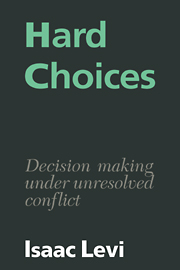Book contents
- Frontmatter
- Contents
- Preface
- 1 MORAL STRUGGLE
- 2 DILEMMAS
- 3 VALUES IN SCIENTIFIC INQUIRY
- 4 CHOICE AND FOREKNOWLEDGE
- 5 VALUE STRUCTURES
- 6 VALUES REVEALED BY CHOICES
- 7 UNCERTAINTY AS A SOURCE OF CONFLICT
- 8 CONFLICT AND SOCIAL AGENCY
- 9 DISTRIBUTING BENEFITS
- 10 UTILITARIANISM AND CONFLICT
- 11 SOCIAL CHOICE THEORY
- 12 CONFLICT AND INQUIRY
- Notes
- Bibiliography
- Name index
- Subject index
4 - CHOICE AND FOREKNOWLEDGE
Published online by Cambridge University Press: 05 June 2012
- Frontmatter
- Contents
- Preface
- 1 MORAL STRUGGLE
- 2 DILEMMAS
- 3 VALUES IN SCIENTIFIC INQUIRY
- 4 CHOICE AND FOREKNOWLEDGE
- 5 VALUE STRUCTURES
- 6 VALUES REVEALED BY CHOICES
- 7 UNCERTAINTY AS A SOURCE OF CONFLICT
- 8 CONFLICT AND SOCIAL AGENCY
- 9 DISTRIBUTING BENEFITS
- 10 UTILITARIANISM AND CONFLICT
- 11 SOCIAL CHOICE THEORY
- 12 CONFLICT AND INQUIRY
- Notes
- Bibiliography
- Name index
- Subject index
Summary
Ability and possibility
According to the proposal informally sketched in 1.2 and to be elaborated in chapter 5, value commitments impose constraints on the ways in which feasible options are evaluated. The totality of value commitments endorsed by an agent delimit a set of permissible ways of evaluation of the feasible options available to the agent. (This set of ways of evaluation will be called a value structure in the more technical discussion.) The set of feasible options which rank best according to some permissible way of evaluation in the value structure comprises the V-admissible options. Given his value commitments and his knowledge of the feasible options, a rational agent ought to restrict his choice to the set of V-admissible options.
Chapter 5 will elaborate and slightly modify this formula. However, the criterion of admissibility just sketched is intended to apply to the options open to the decision maker or, more accurately, to the options open to the decision maker insofar as the decision maker recognizes them to be available to him. In this chapter, some remarks will be made about the kind of assumptions the decision maker must make about feasibility if he is to apply criteria for admissibility of the sort I am proposing (and, indeed, criteria proposed by a broad range of alternative decision theories) in his deliberate decision making. These remarks address questions about feasibility whose answers do not depend on the presence or absence of unresolved value conflict in the decision problem being faced.
- Type
- Chapter
- Information
- Hard ChoicesDecision Making under Unresolved Conflict, pp. 47 - 68Publisher: Cambridge University PressPrint publication year: 1986



